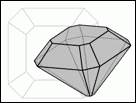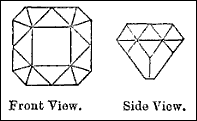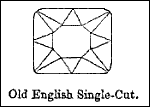Single Cut Diamond
The Single Cut Diamond is one of the antique diamond cuts and is of relative simplicity. A typical single cut has 18 facets - 8 bezel (crown) facets, table facet, 8 pavilion facets and culet (optional). However there have been a few facet variations over time. The single cut stone is generally octagonal in appearance when viewed from directly above the crown, although round single cut diamonds are also seen.
History of the Single Cut Diamond
The single cut dates back to anywhere from the late 1300's to the 1500's, according to various online sources. It may well be ancient, and there seems to be no logical objection on account of the simplicity of the cut. However, it is worth noting that the phrase "single cut" does not appear with reference to gemstones in any books prior to the 19th century that are listed on Google Books. The earliest mention of the single cut diamond comes from John Ramsay M'Culloch's 1844 Dictionary, Practical, Theoretical, and Historical, of Commerce and Commercial Navigation. - which states "Brilliants of 4 carats, if fine, are worth from £100 to £130. I have sold stones, single cut, a little off colour, of this weight, at 80 guineas." [1]
Turning to Charles & John Jacob Holtzapffel's 1850 Turning and Mechanical Manipulation we find the following: "The brilliant cut consists of lozenge-shaped facets alternated with triangles.... the different modifications of this form of facetting, are known as the half brilliant, or single cut; the full brilliant; the split brilliant, or trap brilliant; and the double brilliant, or Lisbon cut; according to the arrangement of the principal facets." [2] However the phrase half brilliant does not appear in literature before that time either!

Single Cut Diamond
diagram by Juergen Schoner
(2004)
image lic. under
CC-BY-SA-3.0

Old Single Cut Diamond
A 38 facet variation
from Harry Emanuel's 1865
Diamond And Precious Stones

Old English Single Cut
From Harry Emanuel's 1865
Diamond And Precious Stones
Perhaps there was another name given to these stones in old times: We have it on good authority that the Mazarin Cut, also known as the double cut brilliant was developed in the mid 17th century; it seems therefore almost certain that the single cut is indeed of ancient origin. Newcomers to the world of old diamonds might be wondering why I am placing emphasis on such detailed researches: The reason is that some legends around old diamonds are either erroneous or deliberate fabrication and care must be taken to examine claims.
There have been some variations on the single cut through the ages. (See facet diagrams on the left.) In the 19th century, there was an "old" single cut of thirty-eight facets (with culet) : Sixteen triangular facets above the girdle with a square table, twelve upper pavilion facets and eight long lower pavilion facets. There was also an Old English Single Cut, also known as the Star Single Cut, which featured a fairly similar arrangement, only with the crown cut in the shape of a star and an octagonal table facet. [3]
Modern Single Cut Diamonds
As is clear from M'Culloch, mentioned above, the single cut was used in old times for diamonds of several carats. However in modern times, the single cut is not used for stones of "ordinary" size, but is one of the predominant cuts used for very small diamonds - because it is simpler, faster and has less facets than brilliant cuts. One doesn't really need anywhere near 58 facets with a tiny diamond! Because of its simplicity the single cut is also less expensive. [4]
Small single cut stones are used as accent stones and side stones and for this reason there are a large number of tiny single cut diamonds in existence. In modern times these small single cut diamonds are often added to less expensive jewelry to add a little extra sparkle, and are also known as Melee Diamonds, 8/8 or Eight Cut. [5]

See more Diamond cuts
Single Cut Diamond info sources:
[4] http://www.jewelry-secrets.com/Diamonds/Single-Cut-Diamonds/What-Are-Single-Cut-Diamonds.html
[5] http://www.diamondguidehq.com/single-cut-diamonds/
[3] http://books.google.com/books?id=e91ReIBPmaQC&pg=PA74
[1] http://books.google.com/books?id=nOcDAAAAQAAJ&pg=PA465
[2] http://books.google.com/books?id=fDQDAAAAQAAJ&pg=PA1322
Note - this website is intended for general informational and entertainment purposes, and should not be considered to be professional consultation. If you are considering purchasing precious stones, be sure to seek the advice of a qualified professional.

